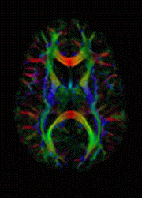MRI pulse sequence
(Redirected from MRI sequence)
MRI Pulse Sequence[edit | edit source]
An MRI pulse sequence is a programmed set of changing magnetic gradients and radiofrequency pulses used in magnetic resonance imaging (MRI) to generate a specific type of image. These sequences are crucial for determining the contrast and quality of the MRI images, allowing for the visualization of different tissues and pathologies.
Basic Concepts[edit | edit source]
MRI pulse sequences are designed to exploit the different relaxation properties of tissues. The two main types of relaxation are T1 relaxation and T2 relaxation. The choice of pulse sequence affects the weighting of the image, which can be T1-weighted, T2-weighted, or proton density-weighted.
T1-Weighted Imaging[edit | edit source]
T1-weighted images are produced by using short repetition time (TR) and echo time (TE). These images are useful for visualizing anatomical detail and are particularly good at showing fat and other tissues with short T1 relaxation times.
T2-Weighted Imaging[edit | edit source]
T2-weighted images are generated with longer TR and TE. These images are excellent for detecting fluid and edema, as they highlight tissues with longer T2 relaxation times, such as cerebrospinal fluid.
Proton Density-Weighted Imaging[edit | edit source]
Proton density (PD) imaging is achieved by using long TR and short TE, which minimizes T1 and T2 effects, allowing for the visualization of the density of hydrogen protons in tissues.
Common Pulse Sequences[edit | edit source]
Several standard pulse sequences are used in clinical MRI, each with specific applications and advantages.
Spin Echo Sequences[edit | edit source]
Spin echo sequences are the most basic and widely used MRI sequences. They consist of a 90-degree RF pulse followed by a 180-degree refocusing pulse, which helps to correct for inhomogeneities in the magnetic field.
Gradient Echo Sequences[edit | edit source]
Gradient echo sequences use variable flip angles and do not include a 180-degree refocusing pulse. They are faster than spin echo sequences and are used in applications such as functional MRI and angiography.
Inversion Recovery Sequences[edit | edit source]
Inversion recovery sequences begin with a 180-degree inversion pulse, followed by a delay and then a standard spin echo sequence. This technique is used to nullify specific tissues, such as fat, in STIR (Short TI Inversion Recovery) sequences.
Advanced Techniques[edit | edit source]
Diffusion-Weighted Imaging[edit | edit source]
Diffusion-weighted imaging (DWI) is sensitive to the random motion of water molecules and is particularly useful in the detection of acute stroke.
Echo Planar Imaging[edit | edit source]
Echo planar imaging (EPI) is a fast imaging technique that captures an entire image in a single shot. It is commonly used in functional MRI and diffusion MRI.
Applications[edit | edit source]
MRI pulse sequences are tailored to specific clinical questions. For example, T1-weighted sequences are often used for anatomical studies, while T2-weighted sequences are preferred for detecting pathology such as tumors or inflammation.
Related Pages[edit | edit source]
Transform your life with W8MD's budget GLP1 injections from $125
W8MD offers a medical weight loss program NYC and a clinic to lose weight in Philadelphia. Our W8MD's physician supervised medical weight loss centers in NYC provides expert medical guidance, and offers telemedicine options for convenience.
Why choose W8MD?
- Comprehensive care with FDA-approved weight loss medications including:
- loss injections in NYC both generic and brand names:
- weight loss medications including Phentermine, Qsymia, Diethylpropion etc.
- Accept most insurances for visits or discounted self pay cost.
- Generic weight loss injections starting from just $125.00 for the starting dose
- In person weight loss NYC and telemedicine medical weight loss options in New York city available
- Budget GLP1 weight loss injections in NYC starting from $125.00 biweekly with insurance!
Book Your Appointment
Start your NYC weight loss journey today at our NYC medical weight loss, and Philadelphia medical weight loss Call (718)946-5500 for NY and 215 676 2334 for PA
Search WikiMD
Ad.Tired of being Overweight? Try W8MD's NYC physician weight loss.
Semaglutide (Ozempic / Wegovy and Tirzepatide (Mounjaro / Zepbound) available. Call 718 946 5500.
Advertise on WikiMD
|
WikiMD's Wellness Encyclopedia |
| Let Food Be Thy Medicine Medicine Thy Food - Hippocrates |
Translate this page: - East Asian
中文,
日本,
한국어,
South Asian
हिन्दी,
தமிழ்,
తెలుగు,
Urdu,
ಕನ್ನಡ,
Southeast Asian
Indonesian,
Vietnamese,
Thai,
မြန်မာဘာသာ,
বাংলা
European
español,
Deutsch,
français,
Greek,
português do Brasil,
polski,
română,
русский,
Nederlands,
norsk,
svenska,
suomi,
Italian
Middle Eastern & African
عربى,
Turkish,
Persian,
Hebrew,
Afrikaans,
isiZulu,
Kiswahili,
Other
Bulgarian,
Hungarian,
Czech,
Swedish,
മലയാളം,
मराठी,
ਪੰਜਾਬੀ,
ગુજરાતી,
Portuguese,
Ukrainian
Medical Disclaimer: WikiMD is not a substitute for professional medical advice. The information on WikiMD is provided as an information resource only, may be incorrect, outdated or misleading, and is not to be used or relied on for any diagnostic or treatment purposes. Please consult your health care provider before making any healthcare decisions or for guidance about a specific medical condition. WikiMD expressly disclaims responsibility, and shall have no liability, for any damages, loss, injury, or liability whatsoever suffered as a result of your reliance on the information contained in this site. By visiting this site you agree to the foregoing terms and conditions, which may from time to time be changed or supplemented by WikiMD. If you do not agree to the foregoing terms and conditions, you should not enter or use this site. See full disclaimer.
Credits:Most images are courtesy of Wikimedia commons, and templates, categories Wikipedia, licensed under CC BY SA or similar.
Contributors: Prab R. Tumpati, MD







